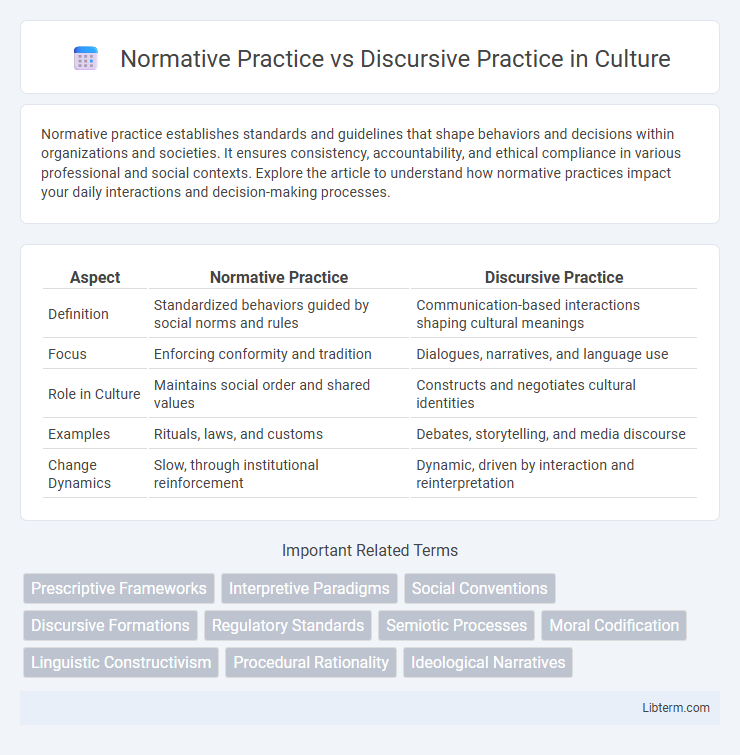Normative practice establishes standards and guidelines that shape behaviors and decisions within organizations and societies. It ensures consistency, accountability, and ethical compliance in various professional and social contexts. Explore the article to understand how normative practices impact your daily interactions and decision-making processes.
Table of Comparison
| Aspect | Normative Practice | Discursive Practice |
|---|---|---|
| Definition | Standardized behaviors guided by social norms and rules | Communication-based interactions shaping cultural meanings |
| Focus | Enforcing conformity and tradition | Dialogues, narratives, and language use |
| Role in Culture | Maintains social order and shared values | Constructs and negotiates cultural identities |
| Examples | Rituals, laws, and customs | Debates, storytelling, and media discourse |
| Change Dynamics | Slow, through institutional reinforcement | Dynamic, driven by interaction and reinterpretation |
Introduction to Normative and Discursive Practices
Normative practices refer to established standards and rules that guide behavior within a society, emphasizing what is considered acceptable or correct. Discursive practices involve the use of language and communication to construct meaning, influence perceptions, and shape social realities. Understanding the distinction between normative and discursive practices is essential for analyzing how social order is maintained and transformed through both formal regulations and everyday interactions.
Defining Normative Practice
Normative practice refers to the established standards, rules, or principles that guide and regulate behavior within a specific social or professional context. It embodies the accepted norms that individuals are expected to follow, shaping judgment and decision-making processes. These standards are often codified in laws, ethical codes, or institutional policies to ensure consistency and accountability.
Understanding Discursive Practice
Discursive practice involves the ways language is used to construct meaning, shape social realities, and influence power dynamics within communication. It encompasses speech acts, dialogues, and narratives that reflect and reproduce cultural norms, identities, and ideologies through interaction. Analyzing discursive practice reveals how language functions beyond mere information exchange, serving as a mechanism for social control and identity formation.
Key Differences Between Normative and Discursive Practices
Normative practice centers on established rules, standards, and expectations that guide behavior within a social or professional context, emphasizing compliance and ethical considerations. Discursive practice involves the use of language, communication, and dialogue to construct meanings, influence perceptions, and negotiate social realities. The key difference lies in normative practice prescribing what ought to be done, whereas discursive practice focuses on how meanings are created and shared through discourse.
Historical Development of Both Practices
Normative practice and discursive practice have evolved distinctly within social theory, where normative practice stems from the philosophical tradition emphasizing societal rules and moral standards shaping behavior. Discursive practice developed through linguistic and social constructivist theories, focusing on language use and communication as mechanisms for creating social reality. Over time, historical shifts in disciplines like sociology and anthropology have increasingly highlighted the interplay between these practices in understanding power and identity formation.
Theoretical Foundations: From Norms to Discourse
Normative practice centers on established norms and rules that govern social behavior, rooted in moral philosophy and legal theories emphasizing obligation and authority. Discursive practice shifts focus to language, communication, and meaning-making processes, drawing from discourse analysis and social constructionism to understand how power and knowledge shape social realities. The theoretical foundations bridge from fixed norms to dynamic discourse, highlighting how rules are not only followed but also interpreted, contested, and transformed through interaction.
Practical Applications in Various Fields
Normative practice directs behavior through established rules and ethical standards, ensuring consistent decision-making in fields like law, healthcare, and education. Discursive practice shapes understanding and meaning via communication and dialogue, crucial for conflict resolution, marketing strategies, and social research. Both practices integrate to enhance organizational culture and policy development by balancing rule-based actions with adaptive conversational approaches.
Benefits and Limitations of Normative Practice
Normative practice establishes clear standards and guidelines that ensure consistency and accountability within organizations, facilitating predictable decision-making outcomes. It benefits organizations by providing a structured framework that aligns actions with ethical and professional norms, but it can limit flexibility and adaptability in dynamic environments. The rigidity of normative practice may hinder innovation and responsiveness to unique or evolving situations, posing challenges for organizations needing agility.
Strengths and Challenges of Discursive Practice
Discursive practice excels in capturing the dynamic and contextual nature of communication, allowing for nuanced interpretation of language use in real-world interactions. Its strength lies in uncovering underlying social power structures and meaning-making processes embedded in discourse. Challenges include its complexity in analysis, potential for subjective interpretation, and difficulty in establishing clear-cut conclusions compared to more rule-based normative practices.
Integrating Normative and Discursive Approaches
Integrating normative and discursive approaches enhances organizational analysis by combining the evaluative criteria of normative practice with the meaning-making processes of discursive practice. This integration allows for a comprehensive understanding of how values and norms influence communication patterns and social interactions within institutions. Employing both frameworks supports more effective decision-making and ethical governance in complex organizational environments.
Normative Practice Infographic

 libterm.com
libterm.com